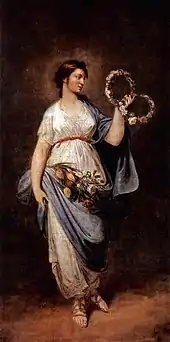Vesna
Vesna (Cyrillic: Весна) was a mythological female character associated with youth and springtime in early Slavic mythology, particularly within Croatia,[1] Serbia, North Macedonia and Slovenia. Along with her male companion Vesnik, she was associated with rituals conducted in rural areas during springtime.[2] In the nineteenth century, Russian peasants celebrated the return of spring on March 1 by going out to the fields, carrying a clay figure of a lark on a pivot which had been decorated with flowers. They sang songs naming the spring season Vesna.[3] The word "vesna" is still the poetic word for "spring" in Slovene,[2] as well as Czech and Slovak. In Russian, Polish, Ukrainian, and Belarusian, vesna/wiosna is the actual word for 'spring'. The month February is sometimes named vesnar in Slovene.[2] In Serbian, the word vesnik is used to denote someone who heralds or brings about springtime. It is likely that Vesna was originally a goddess representing the earth during the spring, making her an alternate form of Mokosh.

In mythology
In Slavic mythology, beautiful women called "vesnas" lived in palaces atop mountains where they discussed the fate of crops and of human inhabitants. A magical circle around their palaces kept them from leaving the mountain top except during February, when they would travel in wooden carts down to the valley below. Only certain people were capable of hearing them singing. People who snuck up to their mountain palaces might learn their fates, but risked an unpleasant end if they were caught by the vesnas.[2]
In popular culture
The story of Vesna and the Sun Prince gave inspiration to the 1983 Czechoslovak short film A Ballad About Green Wood, directed by Jiří Barta.[4] Vesna was featured on a Slovenian postage stamp in 2005.[5]
See also
Notes
- "Lost Slavic Mythology". dalje.com. Archived from the original on 2012-05-29. Retrieved Sep 8, 2020.[dead link?]
- "Pošta Slovenije | Zasebno". www.posta.si. Retrieved Sep 8, 2020.
- Abbott (1903), p. 19
- Česká televize (2014). "Balada o zeleném dřevu". ceskatelevize.cz (in Czech). Retrieved 24 March 2020.
- Bogataj, Janez (2005). "Slovenska mitologija – Vesna" [Slovene Mythology – Vesna]. Bilten; poštne znamke [Bulletin: Postage Stamps] (in Slovenian, English, and German) (56). ISSN 1318-6280.[dead link?]
References
- Abbott, George Frederick (1903). Macedonian Folklore.
External links
 Media related to Vesna at Wikimedia Commons
Media related to Vesna at Wikimedia Commons